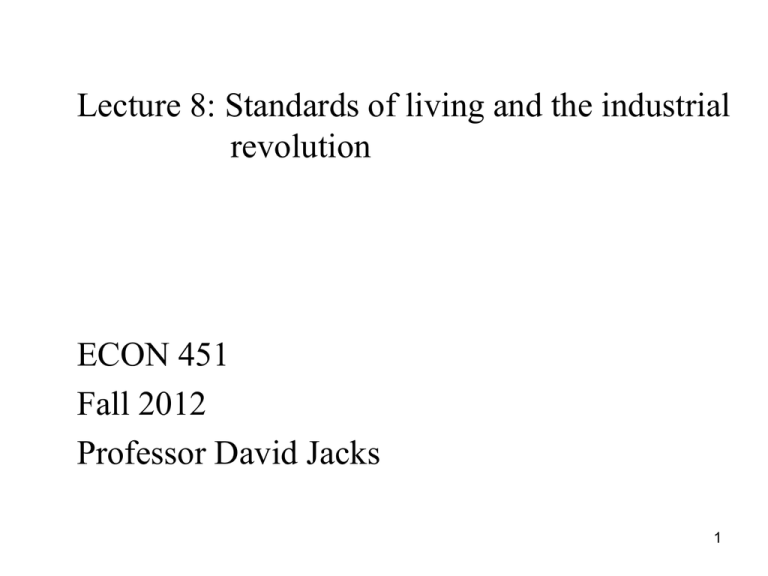Lecture 8: Standards of living and the industrial revolution ECON 451
advertisement

Lecture 8: Standards of living and the industrial revolution ECON 451 Fall 2012 Professor David Jacks 1 The lot of the average worker and their physical standard of living has generated controversy from the time of the IR itself. Renewed interest as ROW followed the path of Britain…and like the old/new school debate Introduction 2 Convenience of organizing the debate around central questions in the literature: 1.) Why are we interested in this? Somewhat of a philosophical issue Four questions 3 1.) Why are we interested in this? Also, opens up big questions about trade-offs associated with economic growth Four questions 4 2.) Er…what is the standard of living? Obvious components Non-obvious components Four questions 5 3.) Um…the standard of living for whom? Big distributional consequences Standard of living for individuals or households? Four questions 6 4.) Even if real wages/incomes capture everything, how do we measure them? Wholesale or retail prices? What is the basket of consumption? Variation? Four questions 7 4.) Even if real wages/incomes capture everything, how do we measure them? Incorporating different goods. Four questions 8 We should also note the general environment in which the industrial revolution was taking place. Namely, the key period from 1793 to 1815 was one of continuous war for the English. Complicating factors 9 Powerful influence on British food prices: although a net calorie exporter, Britain reliant on imports for roughly 20% of its grains. Highly inelastic (SR) demand curves always lead to radically higher prices… Complicating factors 10 Connection to SOL? War-related price movements generate a lot of uncertainty about movement in SOL (wages easy, not so much prices…) Complicating factors 11 Given this statistical murk, maybe it makes sense to consider other measures of well-being. Various historians have argued that we look at such things as: 1.) heights; 2.) hours of work; 3.) the human development index. Alternative approaches 12 Steckel (among others) argues for the use of human heights to track changes in welfare. Basic claim: height at a particular age reflects an individual’s history of net nutrition, diet minus claims on the diet from work and disease. Alternative approach #1 13 Conveniently, the average heights are highly correlated with life expectancy at birth and with the log of the GPC. Alternative approach #1 14 Another route is the evolution of the human development index in England at this time. HDI used extensively by the World Bank and aid agencies to measure the level of general development across countries and time. Alternative approach #2 15 Thought to capture “human capabilities”. Generally, three components are computed in index form and HDI is simple average. Alternative approach #2 16 Recent efforts to measure the actual amount of time spent at work to see if England was experiencing an “Industrious Revolution”. IR as an aggregate demand-driven phenomena. Alternative approach #3 17 But timing is off? Seems that the Industrial Revolution drove changes in time use… One thing is for certain: Europeans began to work longer—much longer—in this period. Alternative approach #3 18




